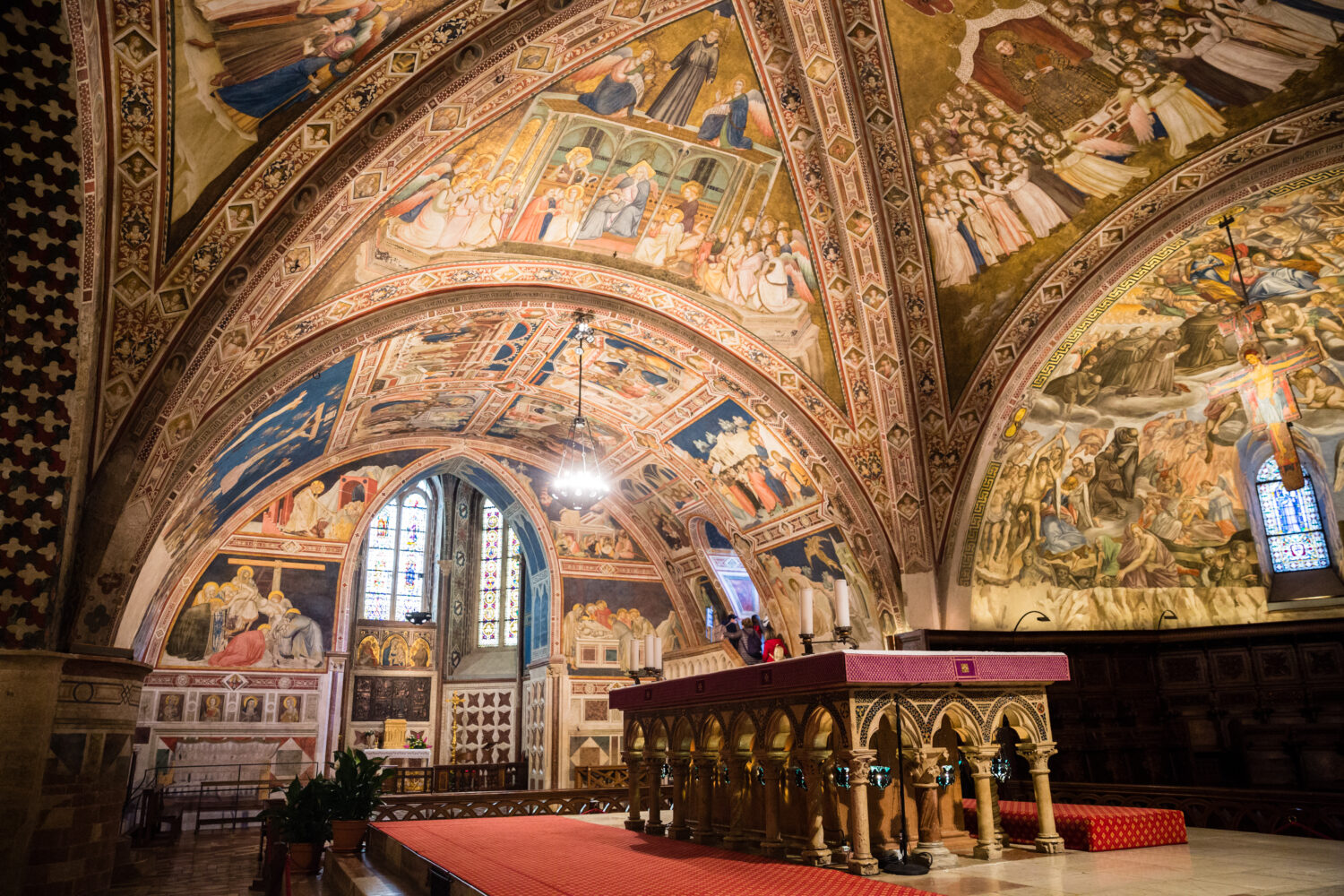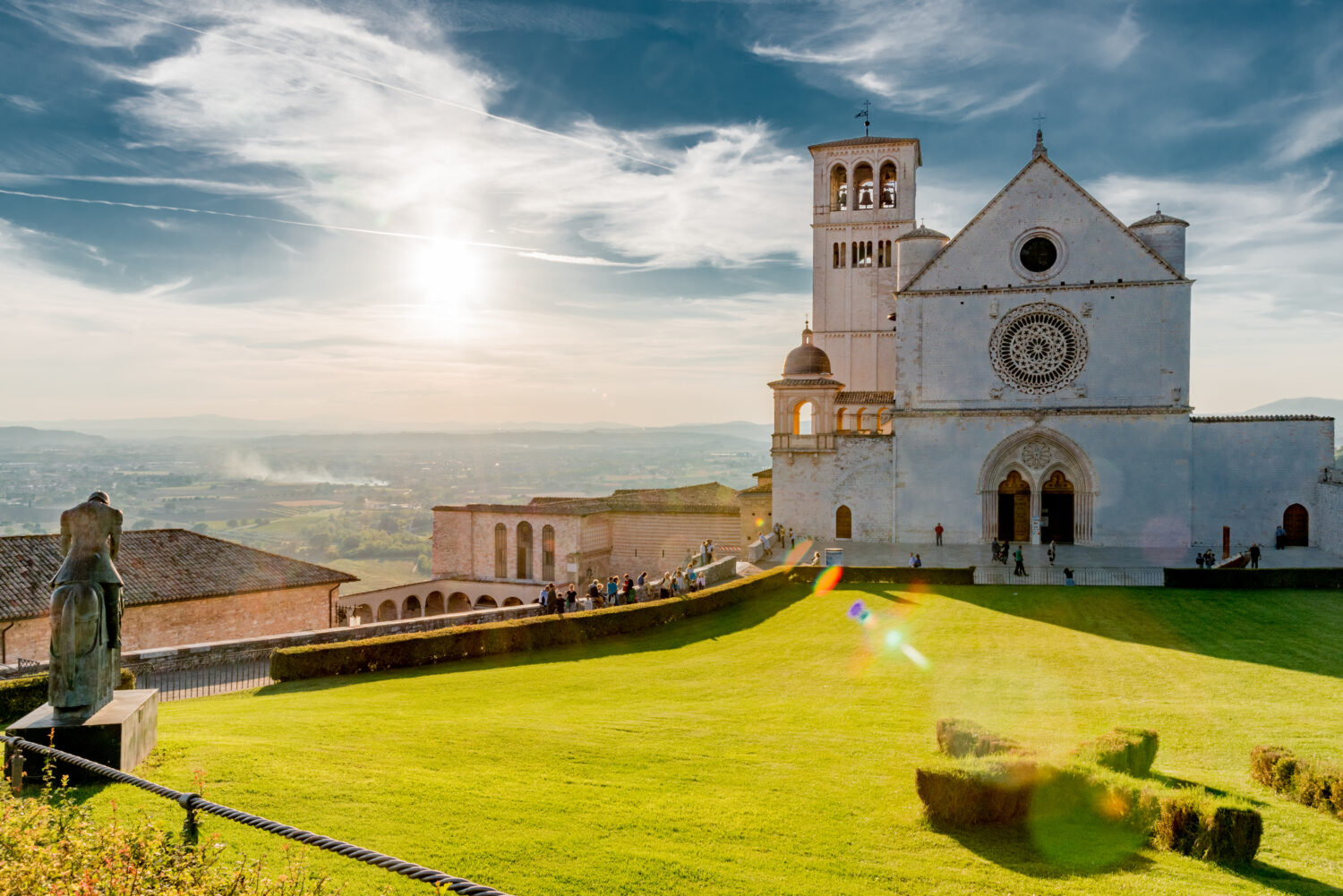Reading time: 5 minutes
Lying on the buttresses of Mount Subasio, in the Umbria-Marche Apennines, the city of Assisi is one of the most beautiful and significant villages in the Umbria region. Most known for being the birthplace of both St. Francis and St. Clare, the Seraphic City contains a real treasure chest of archaeological treasures dating back to the Villanovan period.
Like an open window into the past, Assisi offers glimpses into the Roman, medieval, Renaissance and Baroque eras; glimpses that merge into a composition so harmonious and surprising that they transform every visit to the city into an almost magical experience.
The Basilica of Saint Francis
To begin our visit to Assisi in style there is no better place than the Basilica of Saint Francis. Structured in one Upper Basilica, with its Romanic-Umbrian architecture with heavy influences from the Lombard style; and a Lower Basilica from where it is possible to access Saint Francis’ Tomb, this massive church is Assisi’s spiritual heart. The frescoes and the decorations within the Basilica are the work of renowned artists such as Simone Martini, Cimabue, and Giotto. This latter decorated the walls inside the Upper Basilica with the interesting Cycle of Saint Francis’ Life.

Piazza del Comune
Walking uphill along Via San Francesco, you’ll reach Palazzo Monte Frumentario with its evocative arcaded loggia and then, further on down the road, the small church of Saint Stephen. From there, we can proceed along Via Portica until we enter Piazza del Comune, where the multiple historical roots of the Seraphic Town reveal themselves in all their beauty.
Palazzo dei Priori
Within a relatively small area, in fact, you can also see the Temple of Minerva, of Roman design which surprisingly enshrines a baroque church. Also, Palazzo dei Priori with its Torre del Popolo of medieval design and, on the opposite side of the square, Palazzo Comunale. Finally, from Piazza del Comune, it is possible to reach the ancient Roman Forum (entrance fee) and the Chiesa Nuova, built alongside the birthplace of Saint Francis’ father.
Saint Clare’s Basilica
Proceeding along Via Santa Chiara, we arrive in the square of the same name with its view over the valley and the Basilica of Saint Clare, identifiable by its three massive flying buttresses supporting the left side of the building.
From Piazza Santa Chiara we can climb uphill along Via Sermei and then Via Dono Doni in order for us to reach Piazza San Rufino and the cathedral consecrated to the Patron Saint of the town: Rufino of Assisi. In its simplicity, the Cathedral of Saint Rufino is one of the most prominent examples of Romanic-Umbrian architecture.
Rocca Maggiore Fortress
From Piazza San Rufino, we can finally head toward the highest part of the Seraphic Town, where the fortress named Rocca Maggiore towers above the citadel. From here, enjoy the amazing view over the underlying valley.

Accessible for just a small fee, Rocca Maggiore hosts a permanent exhibition dedicated to the Calendimaggio di Assisi: one of the most prominent medieval festivals in central Italy. Held every year during the first weekend of May, this festival catapults Assisi back in time to the beginning of the 14th century.
Roman Amphitheater
Once we have visited all of the most important sights, we can indulge ourselves by wandering through Assisi and its narrow and arduous alleys: truly, the only way to fully seize the moment and appreciate it in all of its facets.
Don’t miss the Roman Amphitheater, identifiable for its elliptical structure and for the garden enclosed within a walled area; a further example of the convergence of the various historical periods Assisi went through.
Finally, the Eremo delle Carceri located just over 4 kilometers from Assisi, is the most fitting place to end our visit of the town. A prominent Franciscan place of worship where Francis and his followers used to gather to pray, the hermitage is located in a spectacular panoramic position between the mountains at an elevation of 790 meters above sea level.
Have you already chosen this destination?
A Few More Tips
Like many other towns in Umbria, Assisi is not very large and, although it would be more than possible to visit its most interesting landmarks- religious, artistic or archaeological- in just one day, the most ideal way to enjoy its beauty is to devote a whole weekend.
In fact, by spending two days of our time exploring the town, not only can we dive into its timeless atmosphere at our own pace, but we can also have the chance to taste some of Umbria’s traditional dishes.
Moreover, Assisi provides a wide range of accommodations to suit all tastes and every budget making it a wonderful, affordable choice for all kinds of visitors.


